I want to build a battery-powered device that actuates a 24 V solenoid when a button is pressed. How could I power it from a 18650-sized lithium-ion cell? It should work down to about 3 V, when it's nearly flat. Or I could put two cells in series, if necessary.
In my case, the the solenoid seems to be rated at 900 mA, since its coil resistance is 26.6 Ω measured with a multimeter. Only a short pulse is required; there's no need for a hold current.
I'd like to keep the device small, cheap, and robust. If I got a little boost regulator module rated for 30 V / 1 A output, is there any chance it would work from 3 V (or 6 V)? An input current of at least 7.2 A (or 3.6 A) seems like a lot, for both the regulator and the battery.
I could slowly charge capacitors to 24 V (or even 30 V). But I've already experimented with it using a 20 V supply (which IS enough for the solenoid). At that voltage, 6000 µF wasn't enough to actuate the solenoid, but 7500 µF worked. The capacitor bank was annoyingly large though.
My favorite idea is this: build up a current of 900 mA (or more) in a coil and let that discharge into the solenoid. Could this work? It would have to be a big enough coil to power the solenoid long enough for it to actuate. Or would there be sparks or something because the current in the solenoid coil needs time to ramp up from 0? I have included a schematic below (ignore the coil values). A logic circuit would close both switches first, and very soon after that, open SW2.

Best Answer
You want to power a 24V 900ma solenoid (21.6W) from a battery rated at 3.7V 3.4AH (12.58WH)? You could build a charge pump to make 24V from 3..3.7V, but (a) your battery certainly won't last very long between charges, and (b) you should expect significant losses from the charge pump, so your battery should be expected to last an even shorter time between charges.
Your thought of storing energy in a coil would consume a lot of extra energy, too, and as @JohnD pointed out would give you unpredictably high voltage spikes.